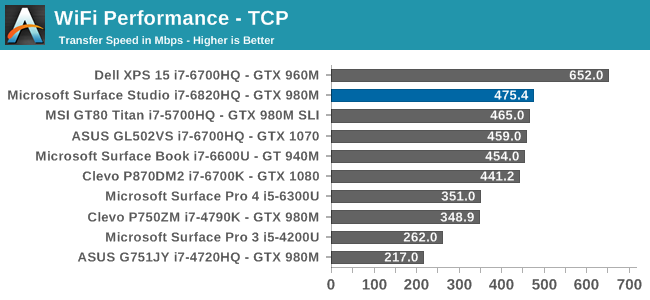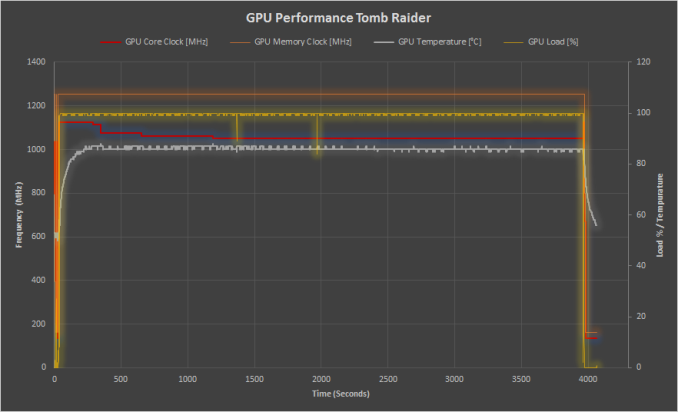The Microsoft Surface Studio Review
by Brett Howse on January 20, 2017 8:00 AM EST- Posted in
- Desktop
- Microsoft
- Surface
- Surface Studio
Wireless
Microsoft has stuck with it’s tried and tested Marvell AVASTAR 802.11ac wireless adapter for the Surface Studio, and they’ve been using this NIC for quite a while on the Surface devices, so this isn’t a surprise. Over the years, the experience with the Marvell adapter has not been the best, although recent driver updates have both improved performance, and made the adapter less prone to not finding networks to connect to.

How times have changed. The Surface Pro 4 in the above graph has the same network adapter, but you can see how far Marvell has come with the drivers. It has been solid so far in regards to connections as well, and hopefully that doesn't change. The Surface Book, with the same adapter, sometimes needs to be restarted to fix the networking even to this day.
The Surface Studio also has the Intel I219-LM Gigabit Ethernet adapter, for those that prefer a wired network connection. It does provide a better experience if you do have a cable handy, since even the best 3x3 802.11ac cards can’t really compete with Gigabit wired.
Audio
When it comes to audio, Microsoft had to put some extra work into the Surface Studio to ensure that the audio experience wasn’t impacted by too severely by moving the display. A lot more engineering went into this than you would expect, and the Surface Studio features a total of seven speakers. Apparently the Surface team decided to go big, or go home, so they fit four speakers into a downward firing grille at the bottom of the display, plus there are two additional speakers in the base. The final speaker is a subwoofer to help out on the low frequencies.
 Four of the Studio speakers are on the bottom edge of the display, and another two plus a sub are in the base
Four of the Studio speakers are on the bottom edge of the display, and another two plus a sub are in the base
The sound quality of the Surface Studio is far better than you would expect for a small, tightly packed device like it is, and having the speakers in multiple locations helps out when the display gets moved into the drafting mode, since the ones on the base can now chip in to make up for the speakers on the display no longer as optimally oriented.
The system gets quite loud, and I measured a maximum of 88 dB(A) when playing music, and the sound was not distorted even at maximum volume. The subwoofer definitely helps out too, with decent frequency response even on the low end of the scale. It’s not a home theater in a box by any means, but it would likely be enough for many people.
Thermals, and Noise
Packing a PC into a space the size of the base of a Surface Studio, especially with a GTX 980M inside, is quite a challenge, but ensuring that the system does not overheat, even under load, is often too much for small devices like this. There are two fans inside the Surface Studio, and they vent out a row of slots in the black plastic underneath the computer.
When discussing the cooling with the Surface team, they were very proud of the work they had done there, especially the amount of heat dissipated per dB of noise. In order to test the thermal capabilities of the Surface Studio, the Tomb Raider benchmark was run continuously at 1920x1080 Ultra settings, which loads the GPU up to 100%.
The cooling system is very good in the Surface Studio, despite the significant heat generated by the GTX 980M. The system was able to run for five minutes at maximum boost clock of 1126 MHz before the GPU hit the thermal limit of 87°C, at which point it reduced its frequency to 1050 MHz over time, and stayed right there for the rest of the test. Perhaps the most impressive bit is that even with the GPU at 100% load, the sound pressure level with a meter over the keyboard, was just 46 dB(A), and the sound frequency is low enough that it isn’t bothersome. Microsoft did their homework on the cooling system, and the Surface Studio is solid under load.
Where it is let down though is at idle. Despite being very quiet under load, at idle, the system still produces 37.5 dB(A), and the fans constantly run. The CPU and GPU idle around 39°C, which is very reasonable, but the sound is always there. It’s not loud, but it’s always there. For me, desktop systems should be almost silent under light workloads, but that’s not the case on the Studio, which is disappointing.
The other issue on the noise side, at least on this review unit, is that there is a small amount of coil whine when the system has the display off, but it’s not yet sleeping. Most likely, this is the power supply, which is also built into the base of the Studio, coping with the reduced power demand since it isn’t driving the display backlight anymore. Once it goes to sleep, it’s not an issue, but the system does wake up periodically to update email, and the like, so even if it is sitting there asleep on the desk, occasionally the coil whine will come back, and the fans kick in.











197 Comments
View All Comments
Manch - Monday, January 23, 2017 - link
I saw where you mentioned that the stress has to be supported at one end or another but its been proven that it can handle the stress just fine. As for the gap, while aesthetically unpleasing to some, or pleasing to others, I just don't see the big deal. Like others said, it ensures the keys don't contact the screen and unlike some laptops ahem Mac Book, key travel hasn't been sacrificed.BrokenCrayons - Tuesday, January 24, 2017 - link
I'd argue that it's been readily proven that the hinge design has been proven to fail under stress over time and there's little to no information available regarding the ability of the Surface Book to cope well with weight as a consequence to its design. However, there's a healthy dose of common sense that would make it pretty clear that half the plastic and metal would be less effective at supporting pressure from above or below than all of the plastic and metal.Key travel though, that's a point I agree with. Microsoft did manage to get that done in a manner of speaking, but it really didn't have to be that way to begin with if they'd bothered to add a largely unnoticable couple of millimeters of thickness. Instead, just like Apple and other companies, the Surface Book is chasing a pretty meaningless thickness measurement and surrendering functionality to do so. In the case of the Surface Book, that compromise is even more silly because the advantage of reduced thickness is ultimately still lost because there's a gap that ultimately makes the system thicker than it would have been had Microsoft recessed the keys and still maintained key travel distance.
jlabelle2 - Thursday, January 26, 2017 - link
- the hinge design has been proven to fail under stress over timeSo I am sure you have sources for that, do you?
- Instead, just like Apple and other companies, the Surface Book is chasing a pretty meaningless thickness measurement
They indeed made exactly the contrary. Instead of doing like Apple an put an almost no travel keyboard and standard hinge for specs bragging, they design a UNIQUE hinge that allow the screen to be further away when deployed for a better balancing and they put one of the maximum travel keyboard for comparably sized keyboard.
The hinge is not showing millimeters as you critizise but adds some at the gain of functionality.
nabnel - Friday, January 20, 2017 - link
Too many people comment and criticize the hinge design without actually understanding its function or why it's there. The hinge is designed to extend the effective base size when the laptop is opened, so that the weight distribution leaves it balanced and not top-heavy when used as a laptop. This is needed because the screen is heavier by a bit much than a typical laptop's screen. The other option wouldve to put more weight into the base, but that would increase the overall weight if the system.vLsL2VnDmWjoTByaVLxb - Friday, January 20, 2017 - link
The hinge design is criticized because it eventually results in a loose connection between the base and screen, the most important vital connection for a laptop. This results in keyboard drops, display resets, total machine crashes, and the inability to, you know, work on your $2000+ device. Having a Tablet isn't worth this instability.It's a design flaw. Every daily-used Surface Book will eventually see the hinge weaken and the above effects happen over and over again.
jlabelle2 - Monday, January 23, 2017 - link
- This results in keyboard drops, display resets, total machine crashesAny sources of that?
I have a Surface Pro 3 and having a removal keyboard never caused me the kind of issues you are claiming.
And having a separate tablet built-in in your laptop CERTAINLY worth it, I assure you.
- It's a design flaw.
The removal screen portion is a "design flaw"? You are kidding right?
BrokenCrayons - Monday, January 23, 2017 - link
"The removal screen portion is a "design flaw"? You are kidding right?"You're missing the context clues, I think intentionally, in order to suggest the idea of a removable screen/tablet is flawed in order to build a credible argument through suggesting that someone else is stating something stupid when that's not at all the case. Dockable tablets arent the problem. The hinge and connection, as already mentioned multiple times in this article's comments, is poorly engineered.
jlabelle2 - Thursday, January 26, 2017 - link
- The hinge and connection, as already mentioned multiple times in this article's comments, is poorly engineered.Which I think is an even more stupid comment. Look again the video of the hinge and compare to anything else on the market and you will realize that it is still unique and unrivalled design.
And anyone that own a Surface Book are praising the hinge, not the contrary.
BrokenCrayons - Thursday, January 26, 2017 - link
Unique doesn't automatically mean "better." I realize you want to defend this for psychological rather than practical reasons and that's completely okay. A handful of people can't help but fall in love with computers and honestly need to in order to justify why something is or isn't better than something else. Men in particular love comparing things and measuring differences in order to reach a conclusion that supports their underlying desires and will go as far as selecting other things that support their mental state. Say, comparing a Surface Book to a bottle of hand sanitizer and saying the Surface Book has better battery life and more storage space. I understand that it often can't be helped, but I encourage you to put human psychology under a critical microscope and attempt to transcend your biology during the process of thinking critically.Manch - Friday, January 27, 2017 - link
Please provide links for this massive hinge failure bc I cant find it.